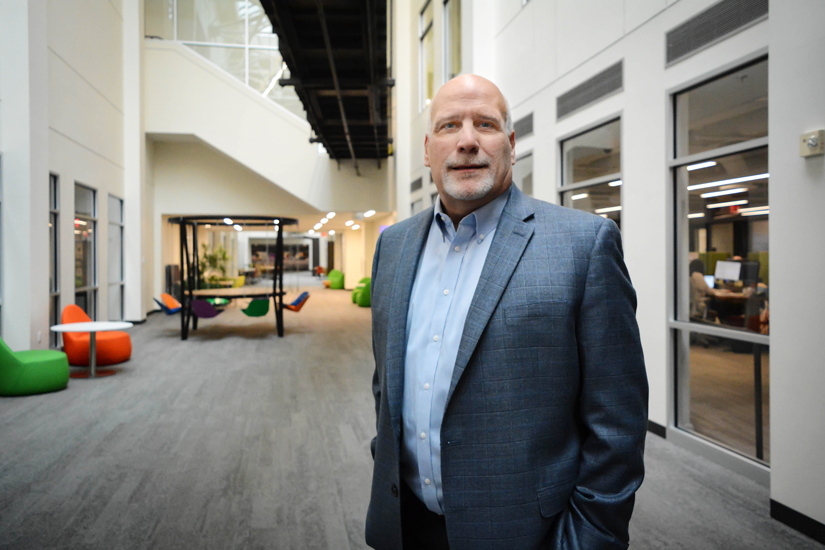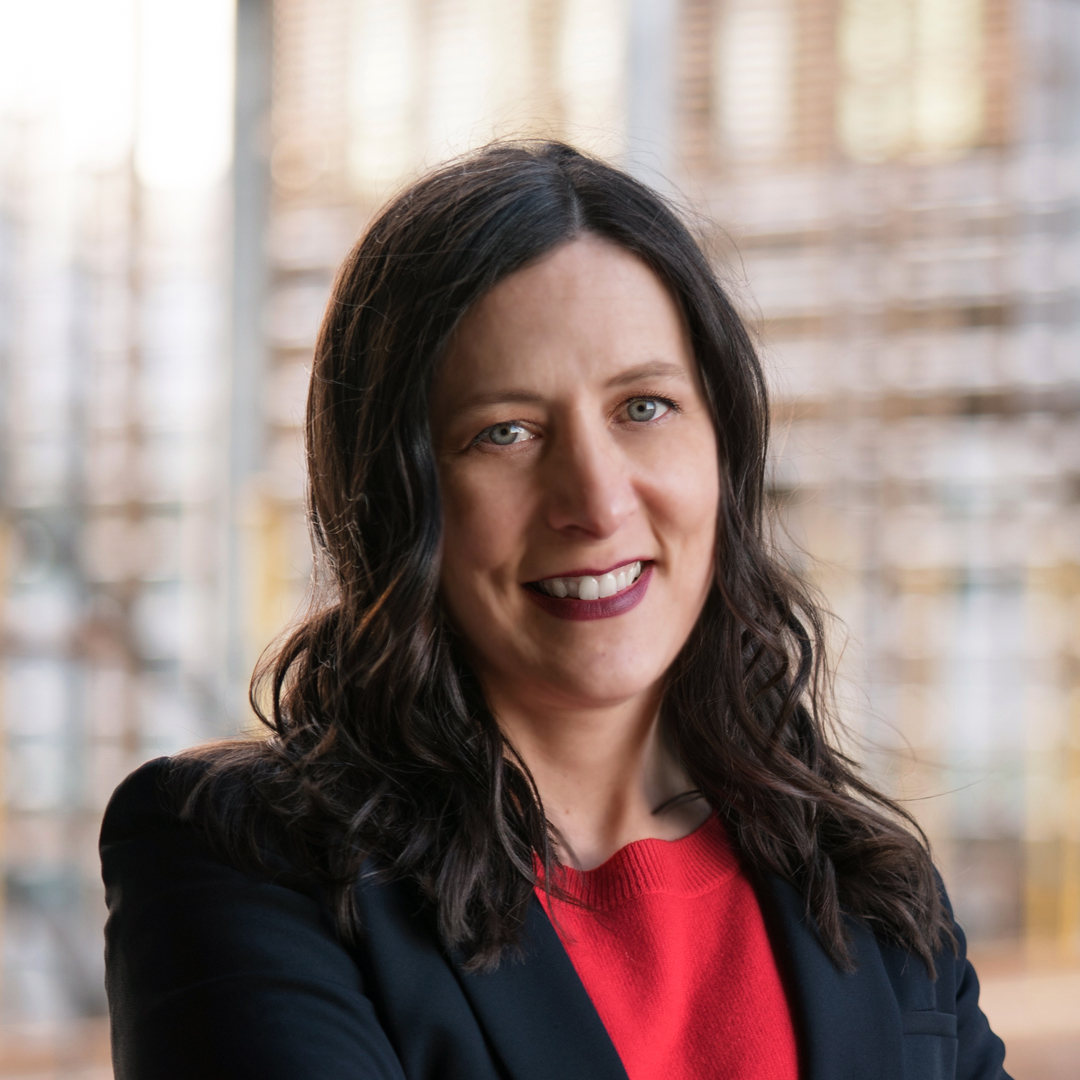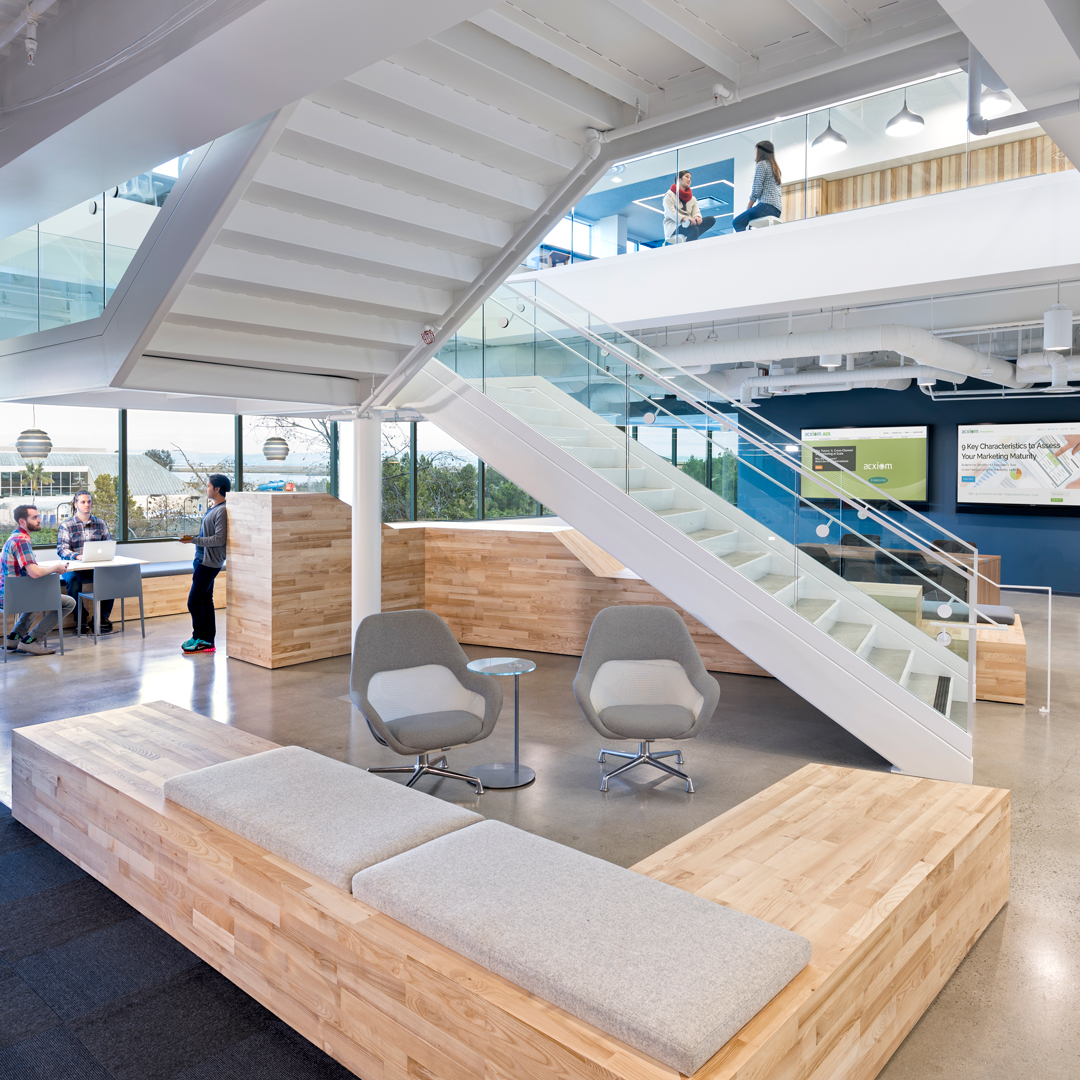|
Getting your Trinity Audio player ready...
|
Anyone who ventures into the expansive, chic offices of athenahealth in Austin, Texas, might first notice the amount of natural light streaming in through the windows. Their eyes might linger on the modern work stations or bi-level cross bridges that give the massive interior space a dramatic, otherworldly feel. Unmistakably, though, they’ll realize they’re in a refurbished power plant.
Finding and using the beauty of old, historic spaces while combining state-of-the-art technique with design and functional engineering is exactly the forte of Mark Blair and Phil Memmott, and an area in which they feel pride. Just take the name of their department, which, in another company, might be titled “planning” or “engineering.” At athenahealth, it’s the “environment” department—one small indicator of the team’s approach. The goal is not only to plan, construct, and maintain buildings, but also to create spaces that meet the broader needs of both employees and the company.

Blair is the executive director of the environment department and hired Memmott, the director of space planning and construction, about five years ago. Both engineers, Blair’s career has spanned from the Merchant Marines to a power plant, corporate design and planning, and then eventually a tenure at athenahealth beginning in 2012. When Memmott joined in 2014, Blair felt a kinship based on their similar thought processes and admired his solid background as an engineer and even-keeled problem-solving skills.
The company was set to undergo a major expansion when Memmott entered the company, and which involved a subsequent five years of renovations to its historic campus in Watertown, Massachusetts, and development of new campuses in Atlanta and Austin.

Blair says he remembers interviewing Memmott right when the expansion was beginning, and the stakes were at an all-time high. “We needed somebody who could hit the ground running,” he recalls. “We looked for someone with the right attitude, who would understand the details of construction. Phil blew everybody out of the water I interviewed that day.”
athenahealth’s major Watertown campus renovation has since been admired for its innovative use of space and light. The project was in its beginning stages and there were lots of decisions, big and small, that needed to be made. This is just what Memmott wanted: he had come from working as a consultant, where the final results and decisions over a project were always out of his hands. This time, he wanted to own the work.
This wave of responsibility was exciting, but it also proved challenging. Memmott recalls that he initially found himself swept up in the small details. “Owning the delivery of a project is much different than consulting,” he says. “For the first 18 months, Mark would ask me how I was doing, and I would be dealing with things like budget, schedule, and scope. I’d be hung up on certain things, to which Mark would respond, ‘Oh, I wouldn’t worry about that.’”
The pair’s working relationship began to grow from there, and their similarities helped foster productive collaboration. “We think a lot alike,” Blair says. “We look at things practically. We don’t want to be trendy. We want to build things that will stand the test of time. We keep it simple; it’s practical—‘simple elegance’ is one of our terms here.”

As Memmott grew more comfortable in his role, he began to make more of the decisions that had daunted him at first, and his management of the organization’s internal politics and practices improved. Blair says Memmott’s “problem-solving attitude” has helped push projects to achieve the pair’s shared vision of spaces that repurpose the old in a thoughtful way, boost employee morale, and most importantly, last.
“Engineers think alike,” Blair adds. “There’s not a lot that has to be said.”
Memmott says that Blair has helped him understand the broader scope of what the team has to accomplish. athenahealth is an established company, providing network-enabled services for health care professionals in areas such as electronic records, billing, and patient engagement, but this also means that its workforce is made up of tech-savvy professionals who also appeal to companies like Uber, Facebook, or Google. “We have to engage in a facet of thinking about how to build spaces that attract and retain top talent,” Memmott explains. “A large part of this is consideration of the space people work in.”

This way of thinking manifests itself through both large-scale projects and mundane details. For example, being ‘on trend’ is not always optimal in creating a dynamic work space, especially if this comes without practicality in terms of function and budget. Memmott recalls a time when there was a clamoring for walls that doubled as whiteboards, using a special paint—they are increasingly popular in Silicon Valley offices. For Blair and Memmott, they were simply expensive and distracting, and didn’t meet any actual needs.
An opportunity for practical problem-solving arrived in athenahealth’s Watertown campus: there was a 1,000-foot building with an atrium in the middle and multiple floors that were difficult to get to from one side or the other. Blair and Memmott decided on a catwalk system, also known as The Spine Project, that would make it easier to traverse floors from north to south and offered visual continuity—as well as simply an impressive thing to look up at from below.
“The building has five levels that are not all on the same plane, so we introduced this multilevel backbone,” Blair explains. “We liken it to Hogwarts. It’s really spectacular.”
The next phase of the Blair and Memmott’s ambitions are to complete the Watertown campus, which will include building more roads and paths and adding utilitarian structures such as parking garages without taking away from the aesthetic feel. However, with athenahealth’s sale to private equity companies and a pending merger with a former unit of GE Healthcare, those plans are on hold until new management takes over and decides the plan’s fate.
Still, Blair hopes they can proceed and roll out this new building phase, which will also introduce shops and restaurants, making athenahealth a full campus where employees could not only have full access to top-tier amenities but also be able to enjoy a functional, inviting community space for them to share with people outside the company as well. “We started such a great thing in Watertown, and we’d love to see it through,” he says. “It’s a 50/50 possibility of whether we can complete what this campus can be. We’ve put so much into this over the years, and we’re just getting started.”
Avison Young is the world’s fastest growing, full-service commercial real estate firm. We are a private company, designed to put our client relationships and their success at the center of everything we do. With the recent acquisition of GVA in London, Avison Young compromises of approximately 5,000 employees in over 120 offices in 20 countries. Learn more at avisonyoung.com.
Stantec is proud to serve as a long-term trusted partner for athenahealth in the revitalization of the Arsenal on the Charles campus. From master planning and complete streets engineering, to landscape design and infrastructure improvements, Stantec delivers tailored solutions designed with the community in mind. Learn more at Stantec.com.



